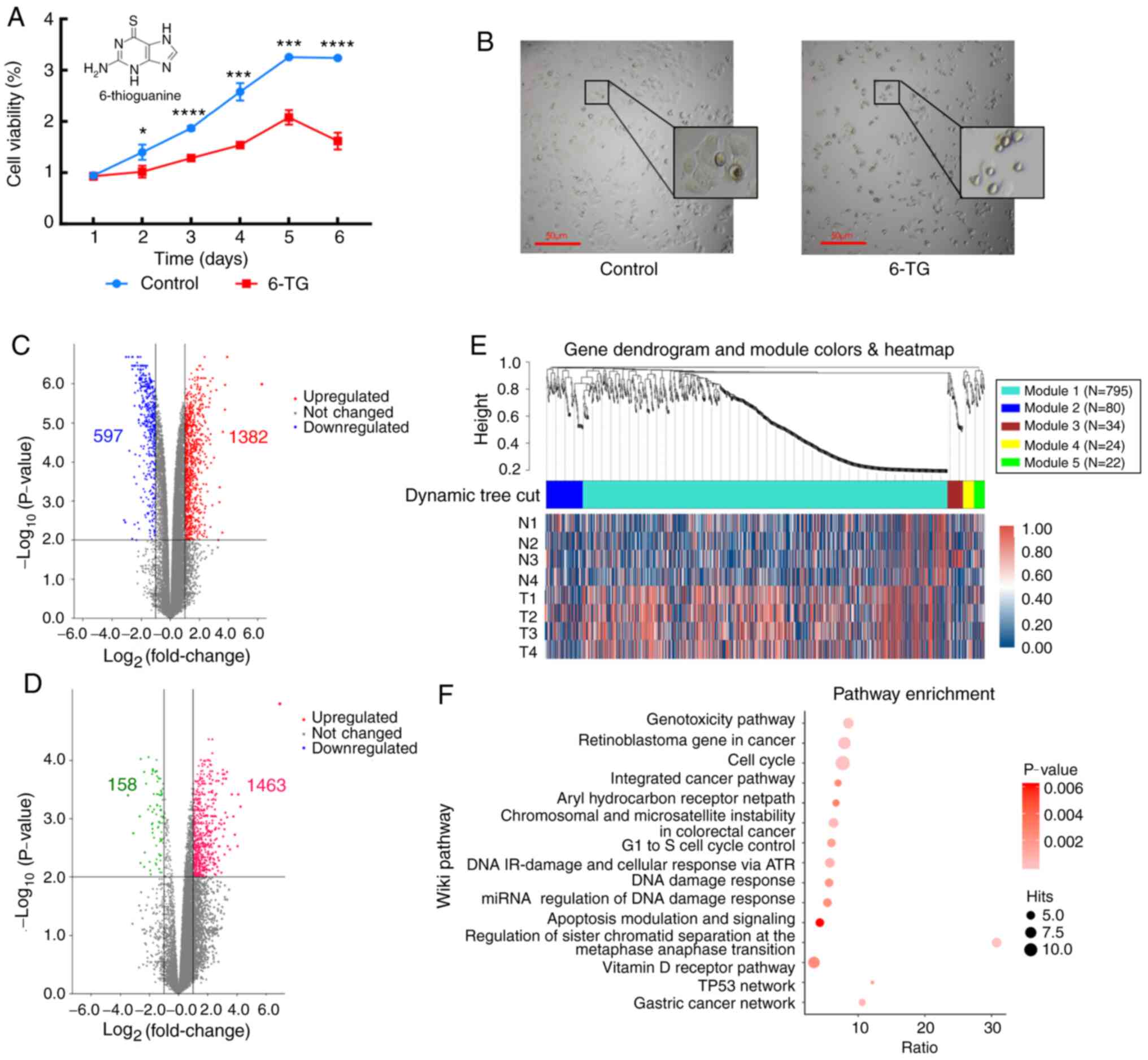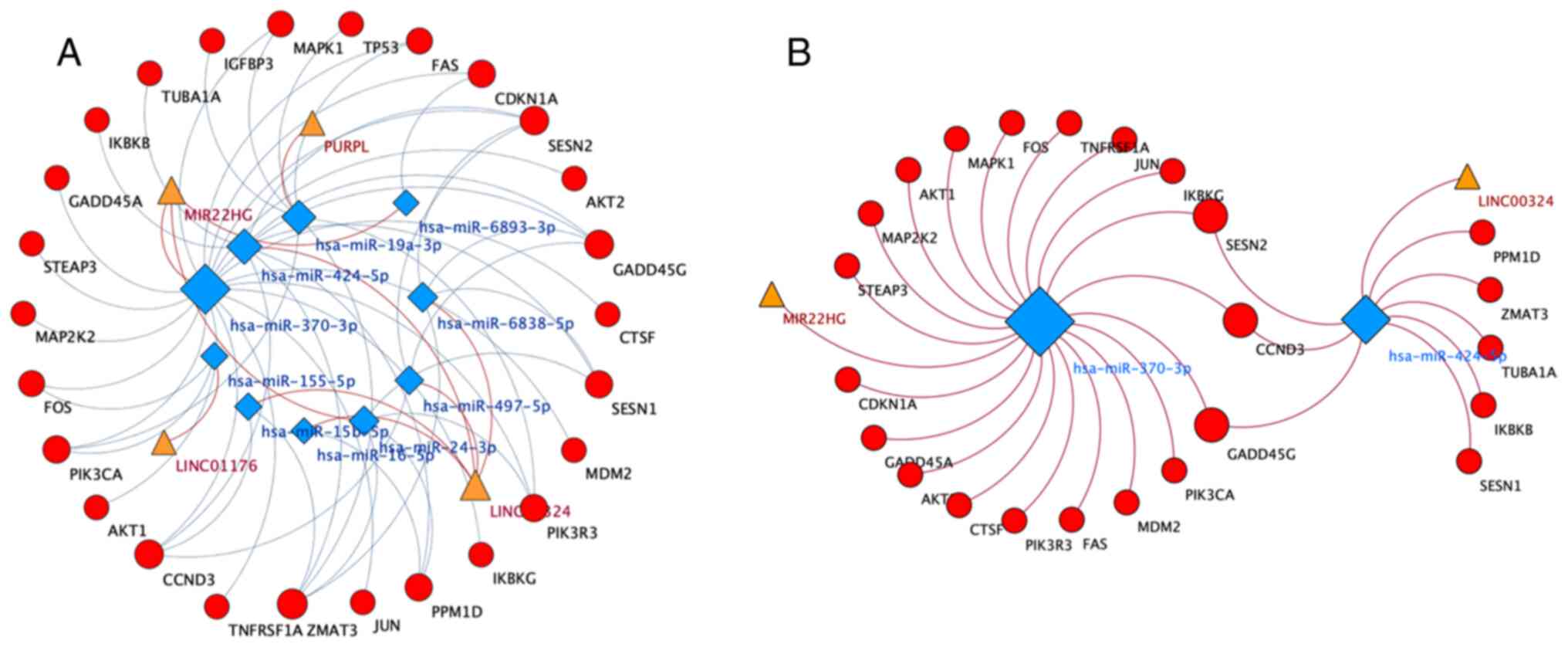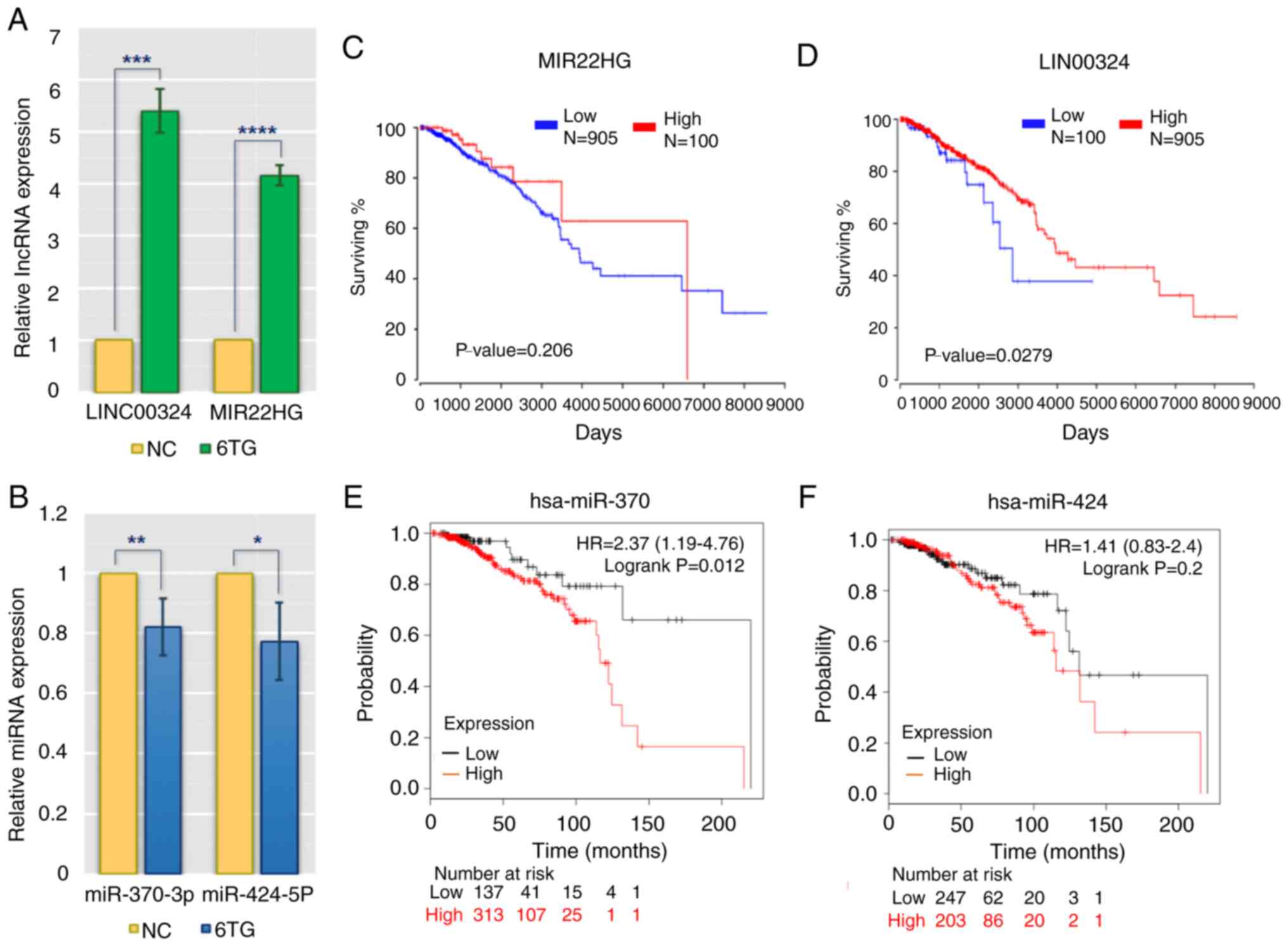|
1
|
Fahad Ullah M: Breast cancer: Current
perspectives on the disease status. Adv Exp Med Biol. 1152:51–64.
2019. View Article : Google Scholar
|
|
2
|
Jeong SB, Im JH, Yoon JH, Bui QT, Lim SC,
Song JM, Shim Y, Yun J, Hong J and Kang KW: Essential role of
polo-like kinase 1 (Plk1) oncogene in tumor growth and metastasis
of tamoxifen-resistant breast cancer. Mol Cancer Ther. 17:825–837.
2018. View Article : Google Scholar : PubMed/NCBI
|
|
3
|
Bray F, Ferlay J, Soerjomataram I, Siegel
RL, Torre LA and Jemal A: Global cancer statistics 2018: GLOBOCAN
estimates of incidence and mortality worldwide for 36 cancers in
185 countries. CA Cancer J Clin. 68:394–424. 2018. View Article : Google Scholar
|
|
4
|
Geng C, Tang P, Zhang Y and Gao W:
Hyponatremia induced by low-dose cyclophosphamide in two patients
with breast cancer. Breast J. 20:442–443. 2014. View Article : Google Scholar : PubMed/NCBI
|
|
5
|
Natori A, Ethier JL, Amir E and Cescon DW:
Capecitabine in early breast cancer: A meta-analysis of randomised
controlled trials. Eur J Cancer. 77:40–47. 2017. View Article : Google Scholar : PubMed/NCBI
|
|
6
|
Shafei A, El-Bakly W, Sobhy A, Wagdy O,
Reda A, Aboelenin O, Marzouk A, El Habak K, Mostafa R, Ali MA and
Ellithy M: A review on the efficacy and toxicity of different
doxorubicin nanoparticles for targeted therapy in metastatic breast
cancer. Biomed Pharmacother. 95:1209–1218. 2017. View Article : Google Scholar : PubMed/NCBI
|
|
7
|
Li C, Liang Y, Cao J, Zhang N, Wei X, Tu
M, Xu F and Xu Y: The delivery of a Wnt pathway inhibitor toward
CSCs requires stable liposome encapsulation and delayed drug
release in tumor tissues. Mol Ther. 27:1558–1567. 2019. View Article : Google Scholar : PubMed/NCBI
|
|
8
|
Karran P and Attard N: Thiopurines in
current medical practice: Molecular mechanisms and contributions to
therapy-related cancer. Nat Rev Cancer. 8:24–36. 2008. View Article : Google Scholar : PubMed/NCBI
|
|
9
|
Munshi PN, Lubin M and Bertino JR:
6-thioguanine: A drug with unrealized potential for cancer therapy.
Oncologist. 19:760–765. 2014. View Article : Google Scholar : PubMed/NCBI
|
|
10
|
Dubinsky MC, Feldman EJ, Abreu MT, Targan
SR and Vasiliauskas EA: Thioguanine: A potential alternate
thiopurine for IBD patients allergic to 6-mercaptopurine or
azathioprine. Am J Gastroenterol. 98:1058–1063. 2003. View Article : Google Scholar : PubMed/NCBI
|
|
11
|
Kim I, Choi YS, Song JH, Choi EA, Park S,
Lee EJ, Rhee JK, Kim SC and Chang S: A drug-repositioning screen
for primary pancreatic ductal adenocarcinoma cells identifies
6-thioguanine as an effective therapeutic agent for TPMT-low cancer
cells. Mol Oncol. 12:1526–1539. 2018. View Article : Google Scholar : PubMed/NCBI
|
|
12
|
Li H, An X, Zhang D, Li Q, Zhang N, Yu H
and Li Z: Transcriptomics analysis of the tumor-inhibitory pathways
of 6-Thioguanine in MCF-7 cells via silencing DNMT1 activity. Onco
Targets Ther. 13:1211–1223. 2020. View Article : Google Scholar : PubMed/NCBI
|
|
13
|
Anastasiadou E, Jacob LS and Slack FJ:
Non-coding RNA networks in cancer. Nat Rev Cancer. 18:5–18. 2018.
View Article : Google Scholar : PubMed/NCBI
|
|
14
|
de Almeida RA, Fraczek MG, Parker S,
Delneri D and O'Keefe RT: Non-coding RNAs and disease: The
classical ncRNAs make a comeback. Biochem Soc Trans. 44:1073–1078.
2016. View Article : Google Scholar
|
|
15
|
Dong Z, Zhang A, Liu S, Lu F, Guo Y, Zhang
G, Xu F, Shi Y, Shen S, Liang J and Guo W: Aberrant
methylation-mediated silencing of lncRNA MEG3 Functions as a ceRNA
in esophageal cancer. Mol Cancer Res. 15:800–810. 2017. View Article : Google Scholar : PubMed/NCBI
|
|
16
|
Conte F, Fiscon G, Chiara M, Colombo T,
Farina L and Paci P: Role of the long non-coding RNA PVT1 in the
dysregulation of the ceRNA-ceRNA network in human breast cancer.
PLoS One. 12:e01716612017. View Article : Google Scholar : PubMed/NCBI
|
|
17
|
Wang H, Huo X, Yang XR, He J, Cheng L,
Wang N, Deng X, Jin H, Wang N, Wang C, et al: STAT3-mediated
upregulation of lncRNA HOXD-AS1 as a ceRNA facilitates liver cancer
metastasis by regulating SOX4. Mol Cancer. 16:1362017. View Article : Google Scholar : PubMed/NCBI
|
|
18
|
Li H, Wang X, Wen C, Huo Z, Wang W, Zhan
Q, Cheng D, Chen H, Deng X, Peng C and Shen B: Long noncoding RNA
NORAD, a novel competing endogenous RNA, enhances the
hypoxia-induced epithelial-mesenchymal transition to promote
metastasis in pancreatic cancer. Mol Cancer. 16:1692017. View Article : Google Scholar : PubMed/NCBI
|
|
19
|
Salmena L, Poliseno L, Tay Y, Kats L and
Pandolfi PP: A ceRNA hypothesis: The rosetta stone of a hidden RNA
language? Cell. 146:353–358. 2011. View Article : Google Scholar : PubMed/NCBI
|
|
20
|
Xu J, Li Y, Lu J, Pan T, Ding N, Wang Z,
Shao T, Zhang J, Wang L and Li X: The mRNA related ceRNA-ceRNA
landscape and significance across 20 major cancer types. Nucleic
Acids Res. 43:8169–8182. 2015. View Article : Google Scholar : PubMed/NCBI
|
|
21
|
Qi X, Zhang DH, Wu N, Xiao JH, Wang X and
Ma W: ceRNA in cancer: Possible functions and clinical
implications. J Med Genet. 52:710–718. 2015. View Article : Google Scholar : PubMed/NCBI
|
|
22
|
Wang H, Niu L, Jiang S, Zhai J, Wang P,
Kong F and Jin X: Comprehensive analysis of aberrantly expressed
profiles of lncRNAs and miRNAs with associated ceRNA network in
muscle-invasive bladder cancer. Oncotarget. 7:86174–86185. 2016.
View Article : Google Scholar : PubMed/NCBI
|
|
23
|
Zheng L, Xiang C, Li X, Guo Q, Gao L, Ni
H, Xia Y and Xi T: STARD13-correlated ceRNA network-directed
inhibition on YAP/TAZ activity suppresses stemness of breast cancer
via co-regulating Hippo and Rho-GTPase/F-actin signaling. J Hematol
Oncol. 11:722018. View Article : Google Scholar : PubMed/NCBI
|
|
24
|
Fan CN, Ma L and Liu N: Systematic
analysis of lncRNA-miRNA-mRNA competing endogenous RNA network
identifies four-lncRNA signature as a prognostic biomarker for
breast cancer. J Transl Med. 16:2642018. View Article : Google Scholar : PubMed/NCBI
|
|
25
|
Karreth FA and Pandolfi PP: ceRNA
cross-talk in cancer: When ce-bling rivalries go awry. Cancer
Discov. 3:1113–1121. 2013. View Article : Google Scholar : PubMed/NCBI
|
|
26
|
Gao C, Li H, Zhuang J, Zhang H, Wang K,
Yang J, Liu C, Liu L, Zhou C and Sun C: The construction and
analysis of ceRNA networks in invasive breast cancer: A study based
on the cancer genome atlas. Cancer Manag Res. 11:1–11. 2018.
View Article : Google Scholar : PubMed/NCBI
|
|
27
|
Sui J, Li YH, Zhang YQ, Li CY, Shen X, Yao
WZ, Peng H, Hong WW, Yin LH, Pu YP and Liang GY: Integrated
analysis of long non-coding RNAassociated ceRNA network reveals
potential lncRNA biomarkers in human lung adenocarcinoma. Int J
Oncol. 49:2023–2036. 2016. View Article : Google Scholar : PubMed/NCBI
|
|
28
|
Xue WH, Fan ZR, Li LF, Lu JL, Ma BJ, Kan
QC and Zhao J: Construction of an oesophageal cancer-specific ceRNA
network based on miRNA, lncRNA, and mRNA expression data. World J
Gastroenterol. 24:23–34. 2018. View Article : Google Scholar : PubMed/NCBI
|
|
29
|
Chu A, Liu J, Yuan Y and Gong Y:
Comprehensive analysis of aberrantly expressed ceRNA network in
gastric cancer with and without H. pylori infection. J Cancer.
10:853–863. 2019. View Article : Google Scholar : PubMed/NCBI
|
|
30
|
Jia X, Shi Y, Zhu Y, Meng W, He L, Jia Y
and Tong Z: Integrated analysis of mRNA-miRNA-lncRNA ceRNA network
in human HR+/Her-2-breast cancer and triple negative breast cancer.
J Comput Biol. 27:1055–1066. 2020. View Article : Google Scholar : PubMed/NCBI
|
|
31
|
Yao Y, Zhang T, Qi L, Zhou C, Wei J, Feng
F, Liu R and Sun C: Integrated analysis of co-expression and ceRNA
network identifies five lncRNAs as prognostic markers for breast
cancer. J Cell Mol Med. 23:8410–8419. 2019. View Article : Google Scholar : PubMed/NCBI
|
|
32
|
Li XL, Subramanian M, Jones MF, Chaudhary
R, Singh DK, Zong X, Gryder B, Sindri S, Mo M, Schetter A, et al:
Long noncoding RNA PURPL suppresses basal p53 levels and promotes
tumorigenicity in colorectal cancer. Cell Rep. 20:2408–2423. 2017.
View Article : Google Scholar : PubMed/NCBI
|
|
33
|
Fu X, Wang Y, Wu G, Zhang W, Xu S and Wang
W: Long noncoding RNA PURPL promotes cell proliferation in liver
cancer by regulating p53. Mol Med Rep. 19:4998–5006.
2019.PubMed/NCBI
|
|
34
|
Pan ZH, Guo XQ, Shan J and Luo SX:
LINC00324 exerts tumor-promoting functions in lung adenocarcinoma
via targeting miR-615-5p/AKT1 axis. Eur Rev Med Pharmacol Sci.
22:8333–8342. 2018.PubMed/NCBI
|
|
35
|
Zou Z, Ma T, He X, Zhou J, Ma H, Xie M,
Liu Y, Lu D, Di S and Zhang Z: Long intergenic non-coding RNA 00324
promotes gastric cancer cell proliferation via binding with HuR and
stabilizing FAM83B expression. Cell Death Dis. 9:7172018.
View Article : Google Scholar : PubMed/NCBI
|
|
36
|
Ni X, Xie JK, Wang H and Song HR:
Knockdown of long non-coding RNA LINC00324 inhibits proliferation,
migration and invasion of colorectal cancer cell via targeting
miR-214-3p. Eur Rev Med Pharmacol Sci. 23:10740–10750.
2019.PubMed/NCBI
|
|
37
|
Zhang DY, Zou XJ, Cao CH, Zhang T, Lei L,
Qi XL, Liu L and Wu DH: Identification and functional
characterization of long non-coding RNA MIR22HG as a tumor
suppressor for hepatocellular carcinoma. Theranostics. 8:3751–3765.
2018. View Article : Google Scholar : PubMed/NCBI
|
|
38
|
Qin L, Luo JZ, Tang XL and Han CG:
Identification of long noncoding RNA MIR22HG as a novel biomarker
in thyroid cancer. Pathol Oncol Res. 25:703–710. 2019. View Article : Google Scholar : PubMed/NCBI
|
|
39
|
Su W, Feng S, Chen X, Yang X, Mao R, Guo
C, Wang Z, Thomas DG, Lin J, Reddy RM, et al: Silencing of long
noncoding RNA MIR22HG triggers cell survival/death signaling via
oncogenes YBX1, MET, and p21 in lung cancer. Cancer Res.
78:3207–3219. 2018.PubMed/NCBI
|
|
40
|
Wu Y, Zhou Y, Huan L, Xu L, Shen M, Huang
S and Liang L: LncRNA MIR22HG inhibits growth, migration and
invasion through regulating the miR-10a-5p/NCOR2 axis in
hepatocellular carcinoma cells. Cancer Sci. 110:973–984. 2019.
View Article : Google Scholar : PubMed/NCBI
|
|
41
|
Zhang J, Liu H, Hou L, Wang G, Zhang R,
Huang Y, Chen X and Zhu J: Circular RNA_LARP4 inhibits cell
proliferation and invasion of gastric cancer by sponging miR-424-5p
and regulating LATS1 expression. Mol Cancer. 16:1512017. View Article : Google Scholar : PubMed/NCBI
|
|
42
|
Liu X, Fu Y, Zhang G, Zhang D, Liang N, Li
F, Li C, Sui C, Jiang J, Lu H, et al: miR-424-5p promotes anoikis
resistance and lung metastasis by inactivating Hippo signaling in
thyroid cancer. Mol Ther Oncolytics. 15:248–260. 2019. View Article : Google Scholar : PubMed/NCBI
|
|
43
|
Dai W, Zhou J, Wang H, Zhang M, Yang X and
Song W: miR-424-5p promotes the proliferation and metastasis of
colorectal cancer by directly targeting SCN4B. Pathol Res Pract.
216:1527312020. View Article : Google Scholar : PubMed/NCBI
|
|
44
|
Hou WZ, Chen XL, Wu W and Hang CH:
MicroRNA-370-3p inhibits human vascular smooth muscle cell
proliferation via targeting KDR/AKT signaling pathway in cerebral
aneurysm. Eur Rev Med Pharmacol Sci. 21:1080–1087. 2017.PubMed/NCBI
|
|
45
|
Lyu L, Yao J, Wang M, Zheng Y, Xu P, Wang
S, Zhang D, Deng Y, Wu Y, Yang S, et al: Overexpressed pseudogene
HLA-DPB2 promotes tumor immune infiltrates by regulating HLA-DPB1
and indicates a better prognosis in breast cancer. Front Oncol.
10:12452020. View Article : Google Scholar : PubMed/NCBI
|
|
46
|
Salvador JM, Brown-Clay JD and Fornace AJ
Jr: Gadd45 in stress signaling, cell cycle control, and apoptosis.
Adv Exp Med Biol. 793:1–19. 2013. View Article : Google Scholar : PubMed/NCBI
|
|
47
|
Li T, Xu L, Teng J, Ma Y, Liu W, Wang Y,
Chi X, Shao S, Dong Y, Zhan Q and Liu X: GADD45G Interacts with
E-cadherin to suppress the migration and invasion of esophageal
squamous cell carcinoma. Dig Dis Sci. 65:1032–1041. 2020.
View Article : Google Scholar : PubMed/NCBI
|
|
48
|
Guo W, Zhu T, Dong Z, Cui L, Zhang M and
Kuang G: Decreased expression and aberrant methylation of Gadd45G
is associated with tumor progression and poor prognosis in
esophageal squamous cell carcinoma. Clin Exp Metastasis.
30:977–992. 2013. View Article : Google Scholar : PubMed/NCBI
|
|
49
|
Misiewicz-Krzeminska I, Sarasquete ME,
Vicente-Dueñas C, Krzeminski P, Wiktorska K, Corchete LA, Quwaider
D, Rojas EA, Corral R, Martín AA, et al: Post-transcriptional
modifications contribute to the upregulation of cyclin D2 in
multiple myeloma. Clin Cancer Res. 22:207–217. 2016. View Article : Google Scholar : PubMed/NCBI
|

















